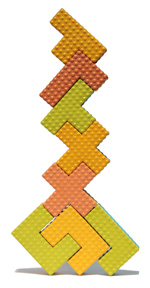57 Meditations on Kicking @$$ in Business and Life"4.8/5 stars" on Amazon
How Universal Design Is Good For The World & For Market Domination
I was telling my designer friend Jessica Zarin Kessin about how there is one brand that dominates my home: The OXO series of award-winning kitchen products.
I own their salad spinner, potato peeler, tea kettle, paper towel holder, tongs, cleaning bucket and travel mug (I’m sure I’m missing something!).

OXO's Products Exemplify Universal Design
Jessica told me that OXO is a leader in a design concept called “Universal Design.”
You know me…
I decide to do a question and answer session with Jessica so that you and I can learn more about Universal Design.
Enjoy!
Q: Hi Jess. I’ve heard Universal Design described in different ways — what’s your Universal Design definition?
I think Universal Design is best described by Ron Mace, one of the pioneers of Universal Design:
“Universal Design is the design of products and environments to be usable by all people, to the greatest extent possible, without the need for adaptation or specialized design.”
Basically, Universal Design considers a broader range of users from the onset, thereby creating a more user friendly product or environment for everyone, independent of age, ability, size or culture.
Q: Why is Universal Design necessary?
Product Design is at the intersection of technology, design, and human factors. When all these areas coalesce we can innovate and create usable products to improve the lives of users.
Generally designers consider users, but it is a natural tendency to think of people like oneself, which usually means healthy, young and typically developing. The human population is not typical, however.
We all have physical, social, emotional, cognitive and environmental factors that vary change throughout our lives.
Disabilities may be chronic conditions or temporary. Most people will experience a ‘disability’ at some point in their lives, a broken leg or shoulder surgery, perhaps.
For those of us lucky enough to live to old age, our physical abilities will naturally deteriorate with time.
As medical technology improves, people are living longer, but the types and severity of their disabilities are increasing. Conditions that would have killed a person not long ago are no longer as great a threat to survival.
Premature babies survive, but often with cognitive or physical disabilities. Soldiers survive injuries that were not previously treatable, but consequently return with disabilities.
The Baby Boomers are starting to see the effects of arthritis, stroke, and other disabilities associated with the aging process.
At the turn of 20th Century, the average lifespan was 47 years. Today it is 76.
My grandparents are in their 90s and live independently, but products and environments were not created to make life easy as one ages; there are challenges at every turn.
Universal Design not only makes products and environments easier for people with disabilities, but it increases the use for everyone.
For example, someone with one arm might have trouble stirring a bowl while cooking, but the same situation might apply to a mother with a toddler on her hip.
A wheelchair user might find doors difficult, but there is no one who hasn’t struggled with a door while carrying bags of groceries.
Universal design makes products and environments more accessible to everyone.
As designers, we need to understand the challenges that ALL people face, not just young healthy professionals. Universal Design breaks down the physical and social barriers between people with and without disabilities.
Q: Would you explain “The Seven Principles of Universal Design?”
The Seven principles of Universal Design were developed with a conference of experts in 1997 at NC State. The experts were comprised of architects, engineers, designers and environmental design researchers.
These principles can be applied to new designs, evaluating existing designs and to the education of designers.
These principles are quoted directly from the Center of Universal Design at NC State.
The Seven Principles of Universal Design
Principle 1 of Universal Design: Equitable Use
The design is useful and marketable to people with diverse abilities:
- Provide the same means of use for all users: identical whenever possible; equivalent when not.
- Avoid segregating or stigmatizing any users.
- Provisions for privacy, security, and safety should be equally available to all users.
- Make the design appealing to all users.
Principle 2 of Universal Design: Flexibility in Use
The design accommodates a wide range of individual preferences and abilities:
- Provide choice in methods of use.
- Accommodate right- or left-handed access and use.
- Facilitate the user’s accuracy and precision.
- Provide adaptability to the user’s pace.
Principle 3 of Universal Design: Simple and Intuitive Use
Use of the design is easy to understand, regardless of the user’s experience, knowledge, language skills, or current concentration level:
- Eliminate unnecessary complexity.
- Be consistent with user expectations and intuition.
- Accommodate a wide range of literacy and language skills.
- Arrange information consistent with its importance.
- Provide effective prompting and feedback during and after task completion.
Principle 4 of Universal Design: Perceptible Information
The design communicates necessary information effectively to the user, regardless of ambient conditions or the user’s sensory abilities:
- Use different modes (pictorial, verbal, tactile) for redundant presentation of essential information.
- Provide adequate contrast between essential information and its surroundings.
- Maximize “legibility” of essential information.
- Differentiate elements in ways that can be described (i.e., make it easy to give instructions or directions).
- Provide compatibility with a variety of techniques or devices used by people with sensory limitations.
Principle 5 of Universal Design: Tolerance for Error
The design minimizes hazards and the adverse consequences of accidental or unintended actions:
- Arrange elements to minimize hazards and errors: most used elements, most accessible; hazardous elements eliminated, isolated, or shielded.
- Provide warnings of hazards and errors.
- Provide fail safe features.
- Discourage unconscious action in tasks that require vigilance.
Principle 6 of Universal Design: Low Physical Effort
The design can be used efficiently and comfortably and with a minimum of fatigue.
- Allow user to maintain a neutral body position.
- Use reasonable operating forces.
- Minimize repetitive actions.
- Minimize sustained physical effort.
Principle 7 of Universal Design: Size and Space for Approach and Use
Appropriate size and space is provided for approach, reach, manipulation, and use regardless of user’s body size, posture, or mobility:
- Provide a clear line of sight to important elements for any seated or standing user.
- Make reach to all components comfortable for any seated or standing user.
- Accommodate variations in hand and grip size.
- Provide adequate space for the use of assistive devices or personal assistance.
Please note that the Principles of Universal Design address only universally usable design, while the practice of design involves more than consideration for usability.
Designers must also incorporate other considerations such as economic, engineering, cultural, gender, and environmental concerns in their design processes.
These Principles offer designers guidance to better integrate features that meet the needs of as many users as possible.
Copyright © 1997 NC State University, The Center for Universal Design.
Q: What is Barrier-Free Design?
Barrier-free design is another term for “handicapped accessible.” It is generally used in architecture to refer to buildings and environments that have ramps and other accessible features.
Many of these features are required by the ADA Guidelines, but Barrier-Free design usually denotes additional features beyond the ADA requirements. Barrier-Free Design is a term more often used in non-English speaking countries.
Universal Design has taken over for Barrier-Free design in many cases. Universal Design considers all the users from the onset of the design process instead of adding additional feature after-the-fact to accommodate more users.
Q: I’ve heard you mention terms like “Assistive Technology” and “Adaptive Technology — would you explain those?
These terms are often used interchangeably. I like to separate them out, but many people would not differentiate between the two.
Assistive technology is any personal device to help a person with disabilities overcome their physical, sensory or cognitive challenges. Assistive technology can be anything from a pair of glasses to a wheelchair, or a prosthetic limb.
Assistive technology has historically made limited advances. Prosthetic limbs are better than they used to be, but there is still a huge cultural stigma associated with them.
Glasses are one of the few bits of assistive technology that have bridged the gap and transformed into the realm of fashion.
While there is room for prosthetics, hearing aides and other assistive technology to follow, this has not yet happened anywhere except eyewear.
Adaptive Technology is a device that allows existing products to be altered or someone with a disability. This could be anything from a large button added to a child toy to make it easier to manipulate, to a text reader for the blind.
Q: What is “Separate Design” versus “Inclusive Design?”
Separate Design is very similar to the debate during the civil rights movement. Is separate really equal?
For example, if you are looking at a building, is the main entrance wheelchair accessible, or are wheelchair users forced to go around to a rear entrance? Inclusive design incorporates accessibility into the core of the design.
All design has an emotional and humanizing factor. Having someone use a separate entrance or a ‘special’ product goes beyond the actual function of getting from point A to point B….It separates and stigmatizes.
Universal Design fights to eliminate this.
Note: The term Inclusive Design is often used interchangeably with Universal Design
Q: You told me over coffee that the OXO design of kitchen products is an example of Universal Design — would you dive into their products to teach us how OXO applies the Seven Principles of Universal Design?
Sam Farber retired from the houseware industry and started to notice his wife’s arthritis affecting her ability to comfortably use kitchen utensils. He set out to create a line that was usable across generations, left and right hand users, men and women and people with disabilities.
In 1990 he founded OXO on these principles.
“For OXO, the principles of Universal Design mean a salad spinner that can be used with one hand; liquid measuring cups that can be read from above without bending over; a toilet brush that bends to reach out-of-the-way places; a backlit oven thermometer that can be read easily through the window of an oven door; kettles with whistle lids that open automatically when tipped to pour; and tools with pressure-absorbing, non-slip handles that make them more efficient.”
Read here for: the OXO Concept as it relates to Universal Design

OXO is the perfect example of how considering different users from the beginning can lead to small changes that can change someone’s life. All the changes that they made allow people with special needs to use these items, but they also make a ‘typical’ user’s experience better.
Q: Would you mention some other leading examples of Universal Design?
Here are a couple of examples that you may encounter everyday and not realize.
1) Door Knobs: A typical doorknob is very difficult for someone with limited hand function or limited strength. An amputee using a prosthetic arm or an elderly man with arthritis may struggle to open a typical doorknob.
A lever style door handle can eliminate many of these struggles. You no longer need to grasp and turn using a large about of force, you can push the handle down with very limited control or strength.
(Try wearing an oven mitt and limiting the amount of strength you exert. This will give you a small hint of where people encounter challenges.)
2) Automatic Doors: An automatic door or a door with a automatic open button are a great way to help users with a disability, but they are also very helpful to those of us that are carrying bags or otherwise have our hands full.
Sidewalk Cut Away: You will notice at the corner of most sidewalks there are cutaways to allow wheelchair users to more easily cross the street. However, these are also helpful to a patent with a stroller, a person pulling a wheeling suitcase or someone using crutches or a walker. These help everyone.
Ikea Directions: Universal Design also relates to people of different cultures or who speak different languages. For anyone who has ever put together a piece of Ikea furniture, you will notice that the instructions do not contain any words. A clear concise series of images allows user who speak any language to understand the directions equally well.
Q: How have you used Universal Design in your design practice?
I have always worked with special needs people and more specifically with children. For the last few years I have been working on a developmental toy company for children of all needs and abilities, Development by Design (DbD).
We used the Universal Design principles to design every one of our toys and games.
After hearing multiple stories about how parents could not find any toys that their kids could use effectively, we decided to design a line of toys that they could.
I teamed up with a pediatric occupational therapist and we brought Universal Design to the toy world. We paid attention to the needs of kids with tactile, auditory and visual sensitivities.
We looked at what kids on the Autism Spectrum needed and we incorporated them into our toys.
For example, we saw kids with poor motor control struggling to use blocks. So we created a set of blocks that were weighted with a grippy texture. This allowed these children to play with blocks for the first time, but also made them easier for typically developing kids.
Typically developing kids found that they could then build bigger crazier towers, which they loved. We also created them in odd shapes to diminish some of the behaviors associated with autism but for the typically developing population, this just spurs creativity in building.
We have a number of examples from DbD, but this is how Universal Design creates better toys for everyone!

In addition to using Universal Design to design our toys, we took it a step further and created an icon system using the same techniques. This icon system was created to clearly communicate the skills that all our toys work on and give parents clear understanding of those terms.
![]()
Besides working on DbD, I have consulted on a number of projects and products to help incorporate Universal Design.
With just a small about of understanding and forethought, most products can be designed to include far more users than they currently do…..the challenge come when you try to change something afterwards instead of incorporating Universal Design into the initial design process.
Q: What are some good Universal Design Web site resources for people to learn more?
The Center for Universal Design at NC State has a great site with lots of information on it. This is where the UD movement got started in the US and one of the only real university deparments in the country.
The Center for Human Centered Design in Boston (previously Adaptive Environments) is another great resource. They have a fantastic resource list with a number of great articles as well as a store with some universally designed products.
If you are interested in Universal Design for travel, check out Scott Rain.
Q: Do you have a favorite Universal Design book or two you recommend?
Design Meets Disability is not exactly on Universal Design, but it is a fascinating book about the ongoing inspiration of disability on design and visa versa.
A number of interesting case studies on Universal Design are available to read about in The Universal Design File: Designing for People of All Ages and Abilities
Q: If someone wants to get in touch with you, Jess, how should they do so?
I am always up for a discussion about design and as I mentioned, I often act as a Universal Design consultant on projects.
When thought about upfront, there is no reason that most items cannot be made more accessible to people in a broader spectrum.
This is true for products, computer applications, websites, environment or most other designed elements.
Please contact me at [email protected].
If you like this article, you may also like Jessica’s How to Master the Design Process: Six Easy Steps.
Tweet 1 Comment